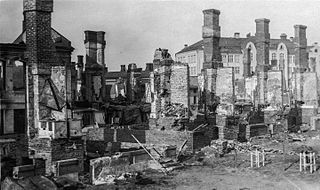
The Finnish Civil War was a civil war in Finland in 1918 fought for the leadership and control of the country between White Finland and the Finnish Socialist Workers' Republic during the country's transition from a grand duchy ruled by the Russian Empire to a fully independent state. The clashes took place in the context of the national, political, and social turmoil caused by World War I in Europe. The war was fought between the Red Guards, led by a section of the Social Democratic Party, and the White Guards, conducted by the senate and those who opposed socialism with assistance late in the war by the German Imperial Army at the request of the Finnish civil government. The paramilitary Red Guards, which were composed of industrial and agrarian workers, controlled the cities and industrial centres of southern Finland. The paramilitary White Guards, which consisted of land owners and those in the middle and upper classes, controlled rural central and northern Finland, and were led by General C. G. E. Mannerheim.

Lahti is a city in Finland and the regional capital of Päijät-Häme. It is located in the Finnish Lakeland. The population of Lahti is approximately 121,000, while the sub-region has a population of approximately 204,000. It is the 9th most populous municipality in Finland, and the sixth most populous urban area in the country.
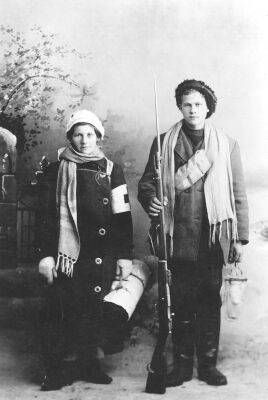
The Red Guards were the paramilitary units of the labour movement in Finland during the early 1900s. The Red Guards formed the army of Red Finland and were one of the main belligerents of the Finnish Civil War in 1918.

The Battle of Tampere was a 1918 Finnish Civil War battle, fought in Tampere, Finland from 15 March to 6 April between the Whites and the Reds. It is the most famous and the heaviest of all the Finnish Civil War battles. Today it is particularly remembered for its bloody aftermath as the Whites executed hundreds of capitulated Reds and took 11,000 prisoners who ended up in the Kalevankangas camp.

Aleksi "Ali" Aaltonen was a Finnish journalist and former lieutenant of the Russian Imperial Army, who served as the first commander-in-chief of the Finnish Red Guards from November 1917 to the end of January 1918. He was executed in Lathi after the Finnish Civil War in May 1918.
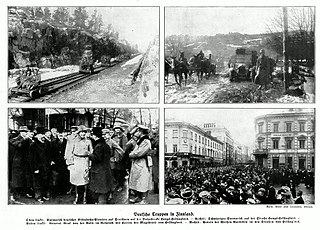
Detachment Brandenstein was a unit of the Imperial German Army commanded by Otto von Brandenstein that fought for the White Finns during the Finnish Civil War. The 3,000 man unit was assembled in Tallinn and landed at Loviisa on 7 April 1918. Its assigned mission was to control Eastern Uusimaa to cut the Red Finns' railway connections between Helsinki and Viipuri. The major operation for Detachment Brandenstein was the Battle of Lahti from 19 April to 1 May.

The Baltic Sea Division was a 10,000 man German military unit commanded by Rüdiger von der Goltz. The core of the division comprised two army brigades from the German Eastern Front: 95. Reserve Infantry Brigade and 2. Guards Cavalry Brigade. They were supported by additional artillery and pioneer troops, and transported to Finland by a naval squadron led by Hugo Meurer.
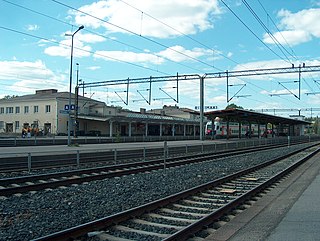
Riihimäki railway station is a railway station located in the town of Riihimäki, Finland.

Finnish Civil War prison camps were operated by the White Finns to hold prisoners of war during and after the Finnish Civil War in 1918.

The Battle of Helsinki was a 1918 Finnish Civil War battle, fought on 12–13 April by the German troops and Finnish Whites against the Finnish Reds in Helsinki, Finland. Together with the battles of Tampere and Vyborg, it was one of the three major urban battles of the Finnish Civil War. The Germans invaded Helsinki despite the opposition of Finnish White Army leader Carl Gustaf Emil Mannerheim who wanted to attack the capital city with his own troops after Tampere had fallen on 6 April. However, the Germans had their own interest in taking Helsinki as quickly as possible and then moving further east towards the Russian border. The city had been under Red control for 11 weeks since the beginning of the war.

Battle of Syrjäntaka was a 1918 Finnish Civil War battle fought on 28–29 April in Syrjäntaka, Tuulos, between the German Baltic Sea Division and the Finnish Red Guards. Thousands of Red refugees were fleeing east, while they were blocked by a small unit of Germans at a highway crossing in the small village of Syrjäntaka. After hours of desperate fighting, the Reds managed to break through and continue their journey. The Battle of Syrjäntaka and the preceding battle in Hauho were the only battles the Germans lost during their one-month military campaign in Finland. They were also the last Red victories of the 1918 civil war. The battle itself was totally unnecessary. It had no effect on the result of the war and neither side gained anything as the fleeing Reds were captured only a couple of days later.

Hennala is a district in the city of Lahti, Finland. It is known of the Stora Enso packaging factory and the former Hennala Garrison which also worked as a concentration camp after the 1918 Finnish Civil War.

All-female units of the paramilitary Red Guards served in the 1918 Finnish Civil War. The first Women's Guards units formed in early February in the main Finnish cities. More than 15 female Guards units were established by the end of March 1918, with a total of about 2,000 women serving. The female Guards units consisted of young industrial workers, maids, and servants. Their average age was about 20, but some were as young as 14. The women served in auxiliary units in combat.
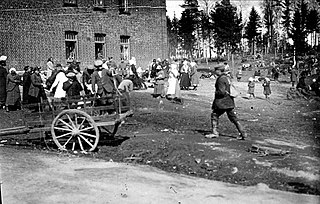
Hennala camp was a concentration camp operating from the beginning of May 1918 to 15 September 1918 in the Hennala Garrison in Lahti, Finland. It was set up for the Reds captured by the White Army after the Finnish Civil War Battle of Lahti.

The Battle of Ahvenkoski was fought during the Finnish Civil War between 10 April and 5 May 1918 at Ahvenkoski, Finland between the German Empire and the Red Guards of the Finnish Socialist Workers' Republic, more commonly known as Red Finland. For most of the battle both sides occupied trenches along the Kymi river. Ahvenkoski and the surrounding Kymi valley region were the last strongholds of the Reds. The battle ended with the surrender of the last of the Red Guards on 5 May, which ended the war with White Finland and Germany defeating Red Finland.

The Battle of Hyvinkää was fought during the Finnish Civil War on 19-21 April 1918, when troops from the German Baltic Sea Division marching from Helsinki conquered the locality from the Reds who had held it for three months. The Germans attacked Hyvinkää from three different directions; from the direction of Klaukkala and Nurmijärvi via the Hanko railway line and along the Tuusula highway and mainline. The main defense positions of the Reds were along the Hanko track in Hyvinkäänkylä, after which fierce battles took place in the station area. After the well-taken invasion, a bloody follow-up began, with Whites executing about 150 Reds, actual or suspected, during May.

The Uusikylä railway station is located in the city of Lahti, Finland, in the district of Uusikylä. It is located along the Lahti–Kouvola line, and its neighboring stations are Nastola in the west and Kausala in the east.

Möysä is the 16th district of the city of Lahti, in the region of Päijät-Häme, Finland.

The Vesijärvi railway station is located in the city of Lahti, Finland, in the district of Kartano. It was one end of the port and industrial siding that branched off of the Riihimäki–Saint Petersburg railway, on the west side of the Lahti railway station.

The Battle of Hämeenlinna was a battle within the Finnish Civil War that took place in the city of Hämeenlinna, Finland on 26 April 1918.























